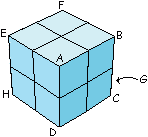|
Professor Buric likes to set his students logic problems using eight normal dice in a 2 cube as shown here.
Let the six faces of the cube be referred to as: ABFE - TOP ABCD - FRONT DCGH - BASE EFGH - BACK AEHD - LEFT BFGC - RIGHT |

|
On one occasion the following clues were given:
- All six faces show four different numbers but each of the numbers 1, 2, 3, 4, 5, and 6 appear four times.
- The numbers on the front can be arranged to make a four-digit square number, and those on the back can form a different four-digit square.
- The sum of the numbers showing on the top is the same total as those on the base.
- The numbers showing at corner F are 2, 3, and 6.
- The numbers seen on the front are consecutive, but not necessarily in order.
- Three odd numbers form corner B, and the product of all the numbers on the top is 180.
- At corner G, the sum of the numbers is only 7, while at corner E, only even numbers are seen, and each of these is either the largest or smallest number seen on its face.
- The numbers on the right side do not include a 6, and only one 5 appears in the top half of the cube.
- At corner C, one of the numbers equals the sum of the other two.



